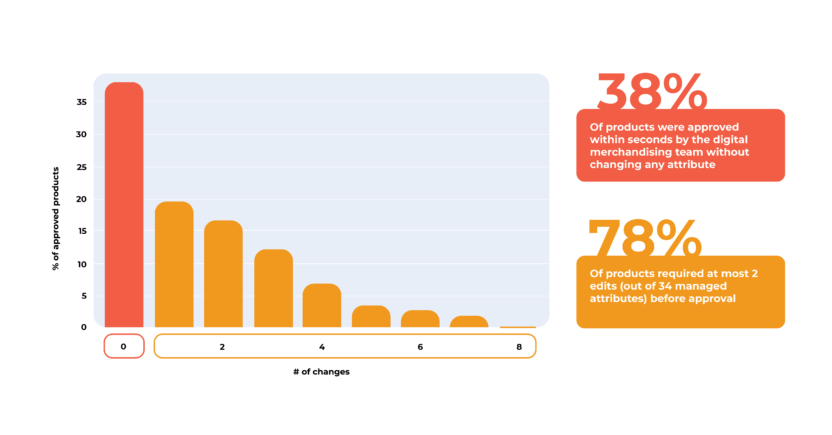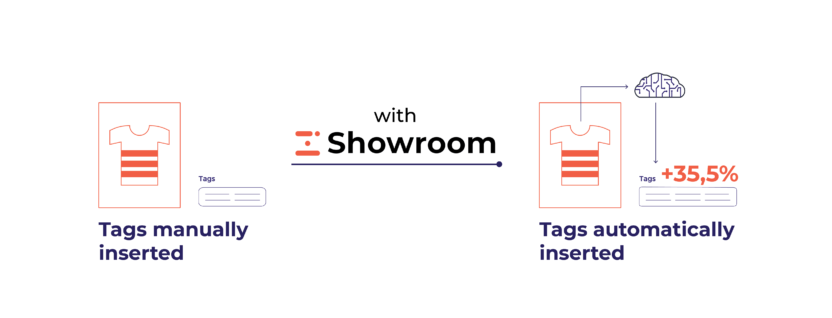
Articles
How to improve the quality of ecommerce catalogs and reduce product returns
You are here:
The state of the e-commerce fashion industry
It is now clear that e-commerce plays a key role in the fashion industry. According to Shopify analysis, the e-commerce fashion industry’s compound annual growth rate, CAGR, is predicted to reach 14.2% from 2017 to 2025. The industry will hit a $672.71 billion valuation by 2023 (Business Wire research).
During the COVID-19 pandemic, e-commerce platforms and websites saved many traditional retailers by providing a continuous and growing revenue stream while physical stores were temporarily closed and foot traffic took a dive.
Today, every retailer knows that they have to strengthen their digital channels and this has become glaringly relevant in the fashion industry.
In the last century, fashion brands and retailers have built their own reputations and customer loyalty by conveying their aspirational messages through their physical storefronts. While TV and print advertising was the means to reach new potential customers, stores were essential to convert them into actual, loyal buyers. Nowadays, print has been replaced by social media and physical stores by e-commerce storefronts.

In this context, customer experience (CX) is a clear strategic investment focus, and AI technology can reshape the digital shopping journey around customers’ desires thanks to curated, rich, and consistent digital product catalogs.
The business impact of poor digital catalog quality
Creating and maintaining a digital catalog is a complex, error-prone, and time-consuming process. It involves multiple activities, from supplier management and photo shooting to content creation and UX curation.
Yet, it is a critical process, since a poorly managed digital catalog can have a terrible impact on the business.

If the e-commerce catalog is not clear, consistent, and user-friendly, potential customers will convert into buyers at a suboptimal rate.
Just like messy visual merchandising in a store puts shoppers off, so a clunky e-commerce UX journey reduces the performance of digital channels.
Extra burden on customer service
Every e-commerce retailer tasks their customer care team with handling prospective customers’ stock inquiries, requests for clarifications, complaints, reviews, and returns. Sizing a proper customer care service is crucial: slow response times and missed inquiries will make you lose a customer. The more precise the descriptions and information on the e-commerce catalog and product detail pages are, the less likely shoppers are to need extra support, lowering the pressure on the customer care service, which can focus on providing a better service.
High cart abandonment rate
Shopping cart abandonment currently causes e-commerce brands to lose a staggering $18 Billion in yearly sales revenue, according to Shopify. The reasons why this happens are different, and some of them are avoidable.
For example, shoppers may decide not to buy the product they’ve placed in their cart because they are confused by the lack of detailed product descriptions or by the quality of the photographs.
High product return rate
According to McKinsey, more than 25% of fashion apparel merchandise bought online is returned, the highest percentage across all industries. Product returns especially impact logistic costs. The National Retail Federation estimates the cost of returns amounts to $101 billion.
Poor product tags and descriptions have a direct impact on high return rates. In fact, incorrect or incomplete information is one of the most common reasons for returns in the fashion industry, alongside images that portray the product differently than its true appearance.
Shoppers need to understand exactly the features and attributes of the products they are buying and they frown upon surprises. If the product they receive at home does not closely match expectations, they will send it back… and potentially leave a bad review, with a negative impact on the brand’s reputation. We have all seen, at least once, posts like “What you order vs what you get”.
Loss of trust
A natural consequence of returning a product is losing trust in that specific e-commerce or brand. 59% of online shoppers who have had unsatisfactory experiences with a given retailer say they are “slightly” or “not at all likely” to trust that retailer (PYMNTS). In terms of business impact, this means that the e-commerce website lost a customer forever.
Why your business needs an optimized digital product catalog
Most of the shortcomings mentioned above can be addressed by carefully curating the information associated with products (i.e. descriptions, tags, categories, and other metadata) and the way they are presented to shoppers, to ensure high customer satisfaction.
Some of the most tangible benefits of an optimized digital product catalog are:
1. Improved search engine rankings
Search engine algorithms tend to reward fresh and unique content. Sites that frequently enrich their content are ranked higher in search results. Taking a cue from this, e-commerce stores need to invest in keeping their catalogs up to date, without errors, and while executing purposeful keyword strategies.
Nowadays, similar and even the same apparel items are sold on multiple e-commerce stores. An enriched catalog can be a competitive advantage by improving SEO performance.
2. Better on-site product discovery experience
Product discovery is the process of enabling shoppers to find the items they’re looking for quickly, while exposing them to new items they might be interested in. It often begins with an on-site product search.
Error-free product tags, descriptions, and attributes positively impact on-site search. By analyzing the most frequent on-site search queries, it is possible to extract the most relevant keywords for customers and use them to properly tag products. This will help them in the discovery, making their customer journey easier and more personalized.
3. Increased conversions
A high-quality catalog helps shoppers better understand the product’s characteristics. When details like color, shape, size, and unique selling propositions are accurate and properly highlighted, it becomes easier for customers to realize whether this is the product they are looking for or not. Evidence from an e-commerce study conducted by Nielsen Norman Group shows that 20% of unsuccessful purchases are due to a lack of product information.
High-quality item information (e.g. matching gold-colored products to a query that contains the keyword “yellow”) increases conversions, average order value, and customer loyalty.
4. Better recommendations for cross-selling and upselling
Detailed product information is helpful in boosting the efficiency of product recommendation engines. It is the virtual equivalent of getting a suggestion from a salesperson who intimately knows all product details. It avoids overwhelming shoppers with too many choices and eliminates the need to go through pages and pages of products just to find the one item they’ll love. A well-executed recommendation carousel, with items exactly tagged and accurately described, can attract the user to buy more products, increasing basket size and average order value. So, in order to do effective cross-selling and up-selling, your catalog needs to incorporate accurate and deep product information.
5. Better forecast of customers trends
One of the key challenges in fashion retail is merchandising forecasting, i.e. the selection of variety, depth, assortment and breadth of product lines to include in the catalog for the following season. In many cases, it still relies on experience, intuition, rules of thumb, trends guessing, and copying competitors’ ideas. Obviously, these tactics are difficult to measure and validate, and they can result in missing sales targets, resulting in price markdowns and clearances at the end of a season.
On the other hand, having each garment in a catalog carefully and appropriately described in every single detail – the number of buttons in a shirt, the variety of colors of a set of blouses, the pattern of the skirts, the length of jeans, the type of buckles in a belt, and so on – is of incredible analytical value. For example, it can be used to track sales fluctuations of some materials, cuts, colors, and patterns across the season and the customer segments. Linking these changes with the external context, like trend changes or advertising effectiveness data can be beneficial for spotting slow sellers, positioning the right products in the merchandising mix, planning new arrivals for the next season, avoiding stock-outs, and scheduling promotions precisely.
Success Story: simplifying catalog management with AI
This case study refers to one of our main customers, the most prestigious and avant-garde chain of department stores in Italy with the best in fashion, beauty, design, and gourmet food.
Our client needed to accelerate the digital catalog management process and reduce the effort of the digital merchandising team which was spending 70% of its time on descriptive product attribute generation, supplier information management, and visual data enrichment. All metadata was produced, managed, and enriched manually by the digital merchandising team, using excel spreadsheets. 10 FTEs managed more than 1,500 brands and over 30,000 SKUs.
Their goals were to:
- reduce the time needed to perform visual enrichment on a single item from 5 minutes to 1 minute;
- improve the quality of product detail pages (i.e. increase the number, accuracy, and consistency of relevant product attributes);
- reduce seasonal editorial workforce peak demand due to the unbalanced yearly efforts in the merchandising process.
They chose ContentWise Showroom Catalog Builder to achieve these objectives.
Thanks to an integration with our customer’s photo shooting system, ContentWise Showroom Catalog Builder has automatically fetched their images, enriched their product description page with visual details, and served them back to the merchandising team through the ContentWise UI, ready to be imported to their e-commerce platform.
The previous process required the merchandising team to write down and cross-check more than 40 attributes, categories, and filters, for every single item. This activity was carried out on both an excel spreadsheet and a product information management (PIM) platform, often without having images at disposal at the right time, making the visual enrichment phase very time-constrained.
Our AI-powered Catalog Builder has reduced human input (number of operations performed manually) to an average of 2 edits per product. Moreover, our solution imported other attributes coming from different sources (PIM, ERP) and empowered the merchandising team with an easy, visual crosscheck and guaranteed consistency across attributes.
Nearly 40% of the products managed by Showroom Catalog Builder didn’t require any edit, lowering the time spent on visual enrichments to a few seconds per item. Another 38% needed at most 2 edits, on either visual attributes or information imported from other systems and fixed during this phase. Overall, in almost 78% of cases, the time spent on the visual enrichment was lower than expected.

Before adopting Catalog Builder, the merchandising team often had no choice but to publish product details pages without enough attributes, due to hard delivery deadlines and lack of enough time to carry out the enrichment process. Now, products are guaranteed to be published with all the necessary attributes, while the quantity of relevant information on the details pages increased by 35.5% on average.

The solution automatically assembles uniform online catalogs integrating data from different sources and applying the same brand stylistic tone of voice to every digital asset. The benefit from these higher-quality catalogs is the improvement of e-commerce KPIs, such as lower exit rates and higher conversion rates, especially when generated attributes are then used to feed on-site search.
Invest in the right solution
As we demonstrated above, digital catalogs are crucial assets for e-commerce merchants, especially in the fashion industry. The problem is that creating a top-notch digital catalog is no easy job. By maintaining a manually-intensive process, retailers risk producing digital catalogs with inconsistent descriptions, missing details, and errors.
Catalog Builder is the ContentWise Showroom’s solution that helps brands and retailers control e-commerce product content quality, enrich the data they already have, and keep it up to date on all channels and platforms thanks to automated metadata management.
Improve the accuracy and consistency of your product information. Simplify catalog management with AI.
Related News
Articles
AI and Fashion – How technology can (re)shape the customer digital experience
Discover the value of an engaging digital customer experience for fashion e-commerce and how AI technology reshapes the digital shopping journey.
